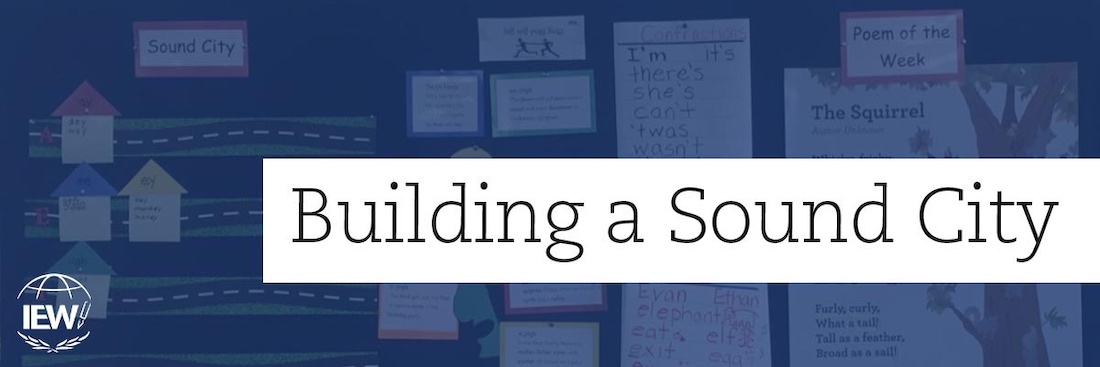
What do city streets, a senior retreat, digraph deliveries, and a silent letter library have in common? They can all be found in a Sound City! Building a Sound City bulletin board delightfully engages students in learning phonemes and phonograms by creating a visual representation of phonics that most would consider an auditory learning experience. All year long, children actively participate in the “construction” of houses, city buildings, and vehicles while quickly developing their phonemic awareness. As phonemic awareness increases, so does reading fluency, reading comprehension, and spelling memory. Seamlessly, students integrate phonics across all subject areas. They begin to “see” it everywhere! Drawing students into the reading and spelling process, Sound City seems almost magical!
The construction of a Sound City is integral to Mrs. Ingham’s reading and writing methodologies. Turn to Appendix 5 in your yellow IEW Classroom Supplement and Lesson Plans binder. You may read more about Sound City there and find a list of the streets, houses, buildings, and vehicles to gradually add to your city. On the Classroom Supplement help page found on the IEW website under Webinars and Recordings, you may listen to two talks on Sound City given by Shirley George, Mrs. Ingham’s daughter and master second grade teacher. The handouts mentioned are in Appendix 5. Listen to Poetry as an Integrator by Mrs. Ingham as well. Appendix 4 includes the handouts for her talk.
How do you construct a Sound City? Throughout the year, the Classroom Supplement and Lesson Plans tells you when to place a building or vehicle on the city based on the sounds found in the poetry lessons. Students enjoy making hammering and sawing noises as the houses are stapled to the bulletin board. They pull words from the poem that contain that sound as well as share words they know. The teacher writes the words on the house, building, or vehicle. Both teachers and students love to watch their city grow!
Some teachers introduce the city sounds through IEW poetry as indicated in the lesson plans, while others choose to introduce them based on their reading curriculum. Either way is fine. Some even choose to do a combination of the two. When introduced through poetry, the sounds will be somewhat familiar to the students when they encounter them during reading instruction. Poetry exposes students to the phonetic sounds. Mastery is not expected at that time, but mastery occurs over time with an easy reference bulletin board.
When teachers develop a Sound City based on their reading curriculum, the houses are added just as they are with the poetry, but in a different order. Students pull words from their reading text to write on the city building instead of from the poem. Either way, students quickly begin to find words in all subjects to be added to the city. Reading, poetry, writing, science, social studies, and history blend together on your wall! Sound City becomes a clue finding, phonics building detective game of sorts.
Below are some example cities spotted in IEW kindergarten, first, and second grade classrooms. If you create a Sound City with your class, please submit pictures to schools@iew.com. We’d love to see them!
Kindergarten Sound City
-
I appreciate the simplicity and readability of this city.
-
The teacher kept it nice and easy his first year teaching with the IEW method.
-
The houses are identical. Clouds are identical. The hospitals with the red cross are identical.
-
Each house has lines on it like student writing paper to assist and remind students how the letters are written on the lines.
-
The street names are clear, making the grapheme on the rooftops accessible.
-
The digraph delivery vehicle is the train found at the bottom.
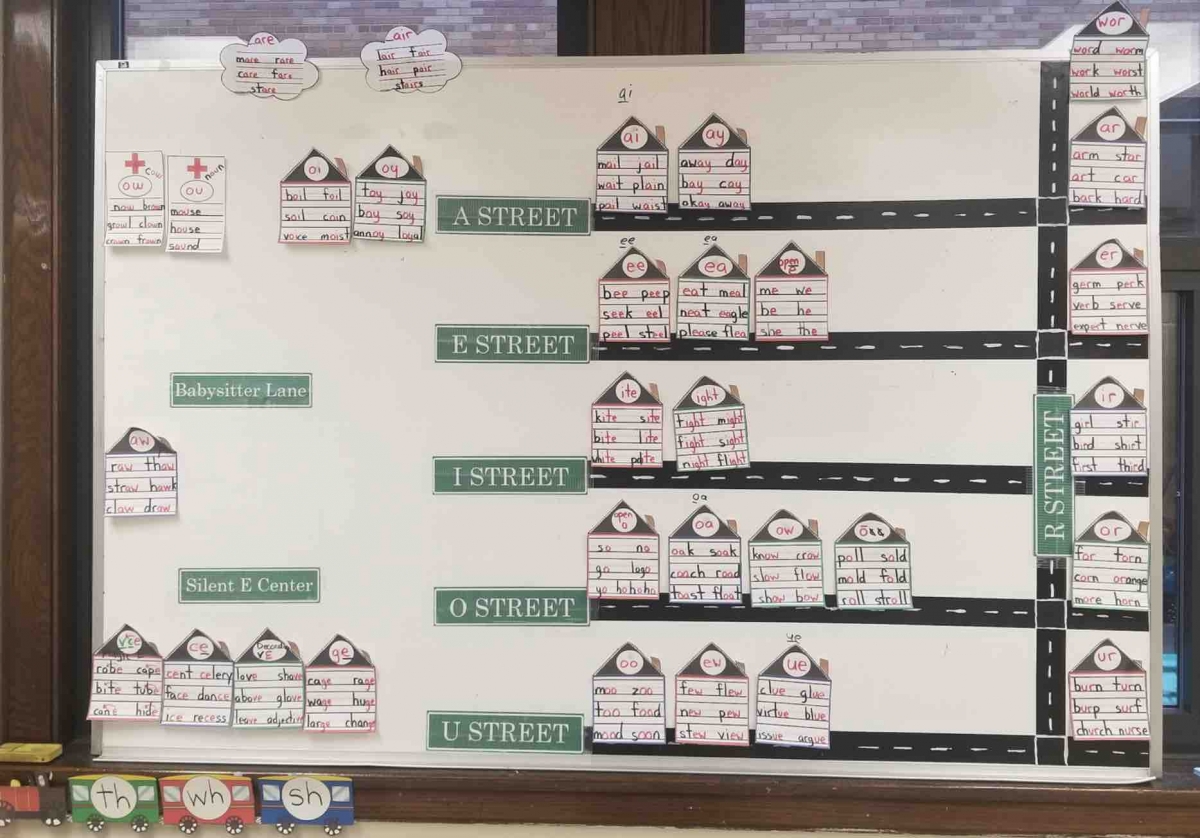
Kindergarten Sound City
-
This is the same kindergarten teacher in his second year using IEW’s method.
-
He added a Sound City sign, changed the rooftop shapes, and added airplanes and ambulances.
-
He placed a jail on the bottom of the city for words that do not follow any of the phonetic rules. Some teachers prefer a timeout area.
-
The houses are a little more colorful.
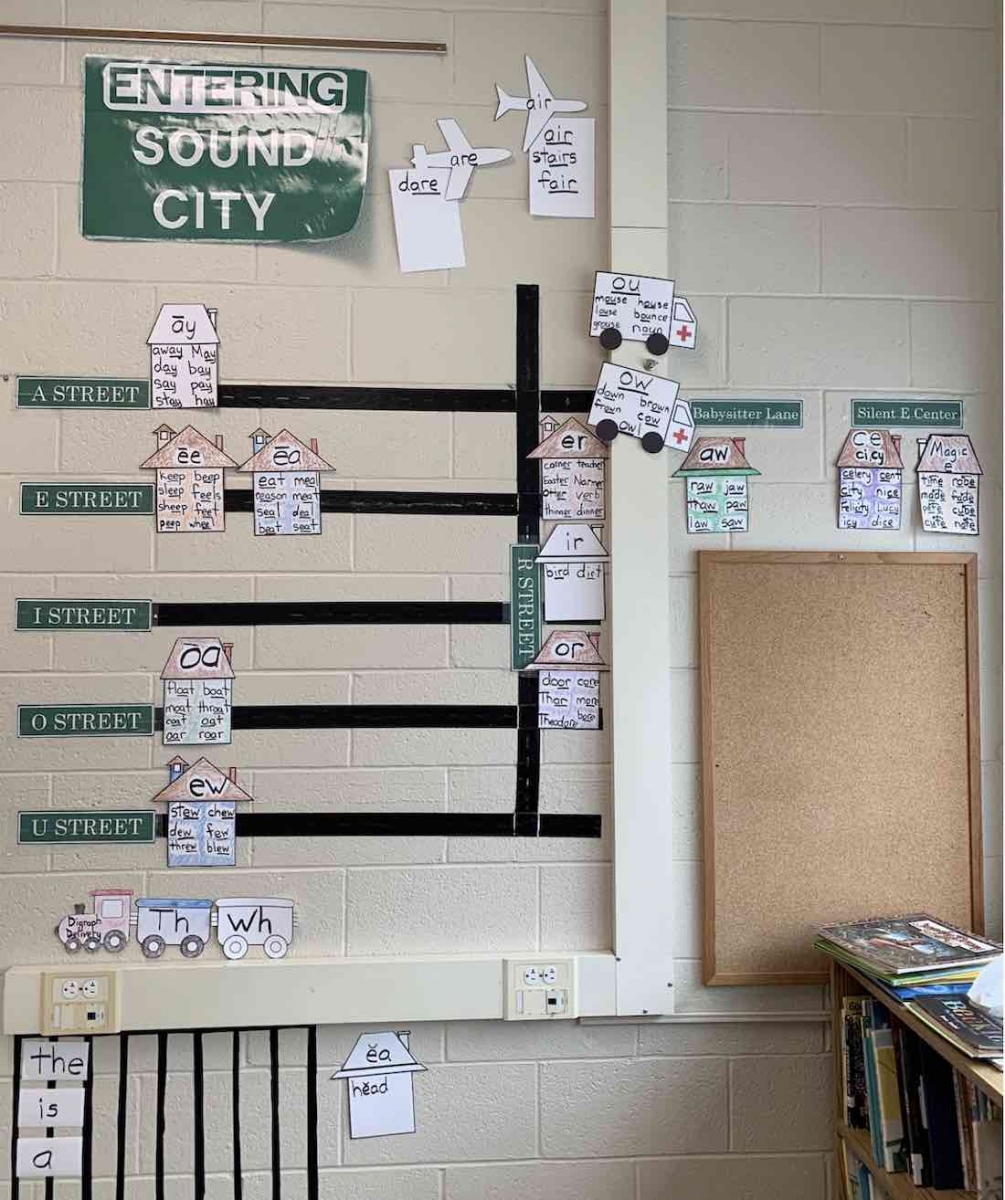
Kindergarten Classroom
Letter Story Cards and Color-Coded Words Banks for Parts of Speech
Adjectives and Verbs
- Word lists are created throughout the year as indicated on the Pacing Chart found behind the Pacing Chart tab in the kindergarten, first, and second grade yellow Classroom Supplement and Lesson Plans. They are then posted on the wall for reference all year long.
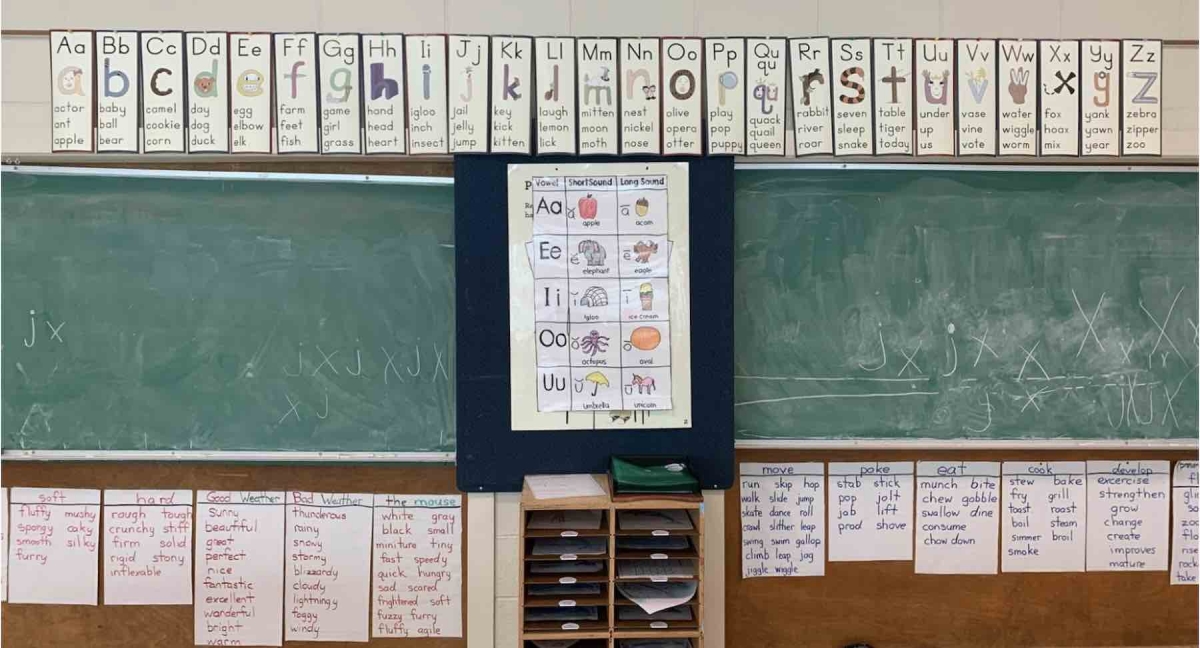
First Grade Sound City
-
The streets are clearly labeled.
-
The houses are colorful rectangles, which are very simple to create.
-
Notice that some of the houses are created by her students.
-
She chose to make digraph delivery trucks with words on the truck for each digraph sound.
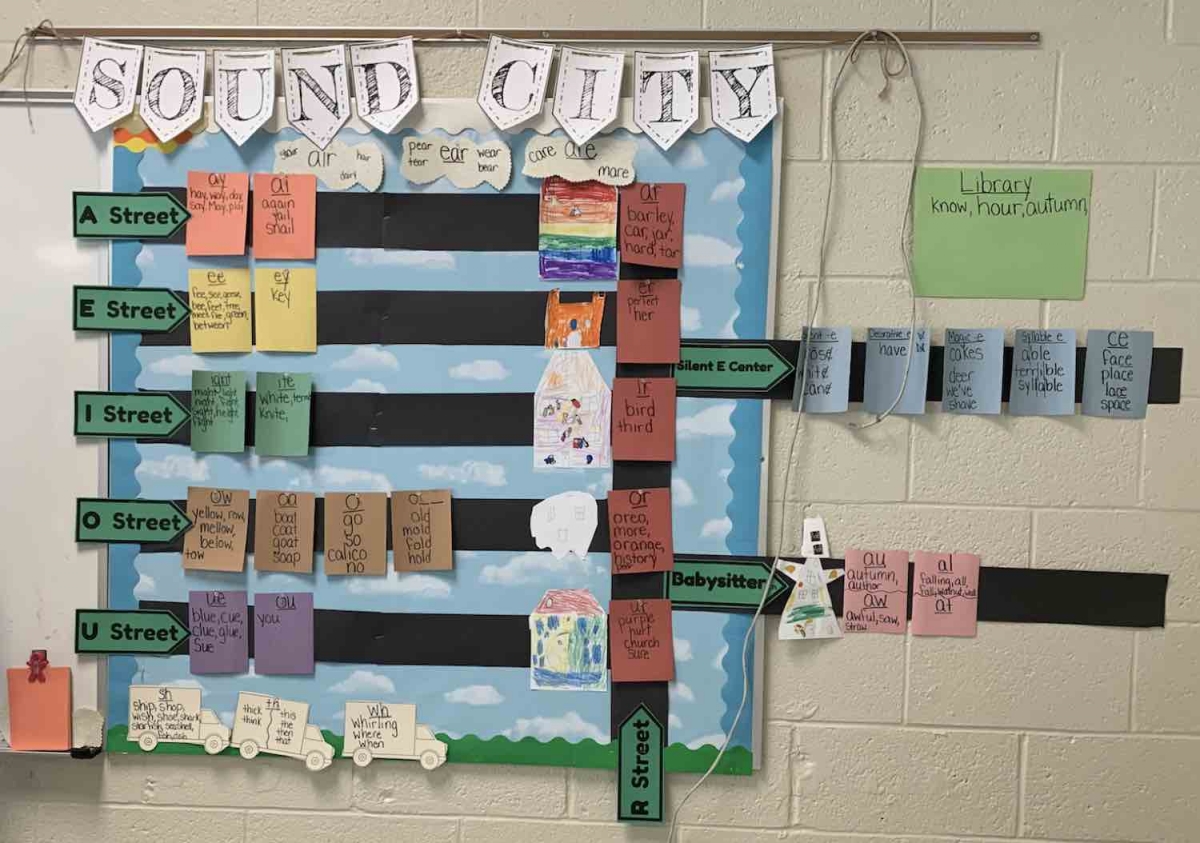
First Grade Sound City
Color Coded Words Banks for Parts of Speech
Nouns, Verbs, Adjectives
-
To keep your word list neat and uniform, consider using the same size paper and the same type or thickness of marker. Notice how each of the word lists below has a thick black line photocopied at the top. The word used to generate the list is written on it, making it easy to refer to when seeking alternative words for writing.
-
Along with the thick line, there are narrow lines photocopied below it. The thick and narrow lines help to maintain a neat appearance and uniformity as the number of lists increases throughout the year.
-
This teacher created an IEW bulletin board, which includes the posters for the week and the Sound City.
-
The black background is rather striking.
-
The streets are bulletin board strips that look like roads and are clearly labeled with red letters.
-
The houses are Post-it® notes with triangle roofs. When the house fills up with words, the teacher places a new Post-it® on top of the old one.
-
She has a jail for words that do not follow any of the phonetic rules. Some teachers choose to create a timeout corner.
-
The “r” is the angry letter that says, “Rrrrrr, rrrrrr, rrrrrr.”
-
Note the contractions list. The same paper is used as the word banks. The contractions are spotted by the children while learning a poem or reading a source text and made into a list for reference. The exercise is much more meaningful than when taught out of context.

This is the same city in the spring. She has more houses on her city, a list of the dress-ups with the school color code, and Gentle Cindy representing the soft “g” and “c” sounds. Magic “e” makes short vowels long.

First Grade Sound City
-
This colorful city was created by a teacher her first year using IEW’s method.
-
All of the components are laminated, making them easy to erase and reuse the following year.
-
The houses for each block are a different color, making the streets clear. Students will learn to look for a specific color of house to find the phonemes for each vowel sound.
-
The building on the top right is the Silent Letter Library, followed by the Silent “e” Retreat, and at the bottom is the Decorative “e” on a fancy house.
-
The digraph delivery trucks are simple and effective. The digraph is easily seen with words listed on the truck.
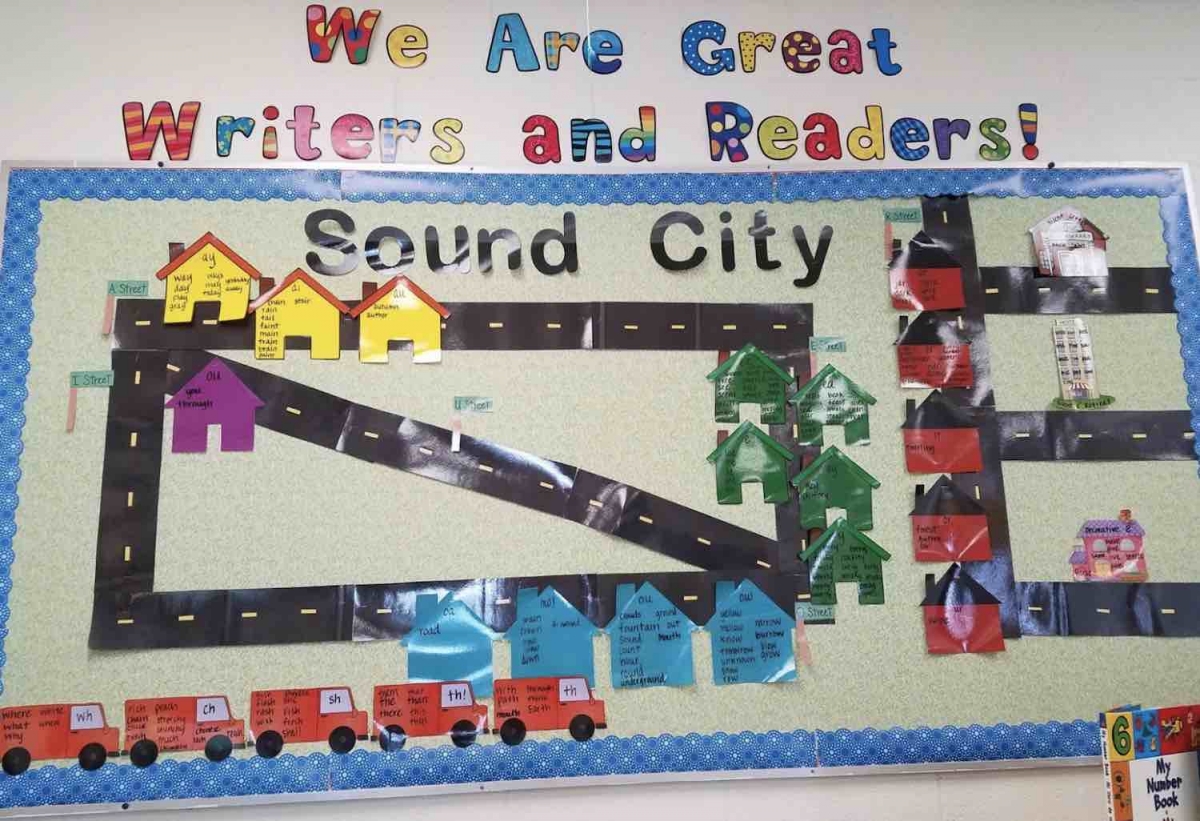
First Grade Sound City
Color Coded Words Banks for Parts of Speech Using Colored Paper
Nouns, Verbs, Adjectives
-
This teacher creates her Sound City following her reading curriculum. She needed to add short vowel streets, so she divided her bulletin board in half.
-
The streets are clearly labeled with the words short and long next to the vowel.
-
The black background creates a calm background for the colorful houses.
-
The clouds represent -ly adverb words.
-
The unit posters, word banks, and the Sound City are altogether creating an Arts of Language Center. The students know just where to look for support while reading and writing.
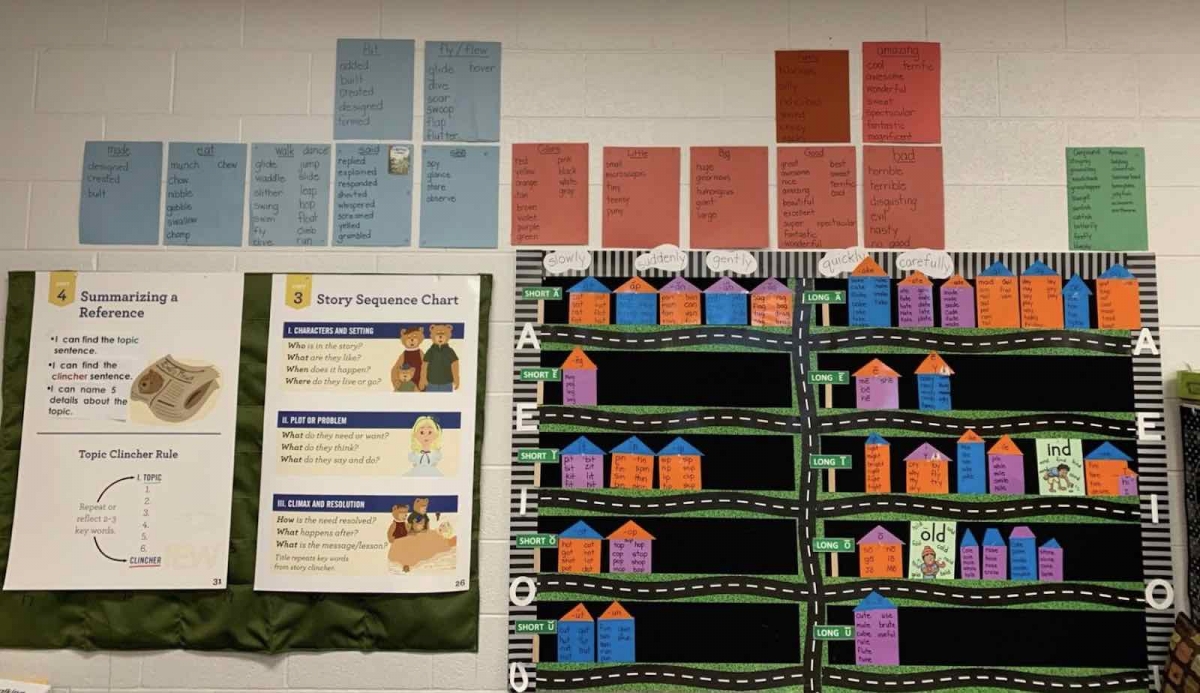
First Grade Sound Safari
-
Instead of city streets and houses, this clever first grade teacher used flatbed trucks and grass huts. Her entire classroom was decorated with a safari theme.
-
The trucks are clearly labeled, making the street visible.
-
The roofs are large enough that the grapheme can be written largely and easily seen. The huts are made of Post-it® notes.

First Grade Sound City
-
This teacher has a small classroom with limited wall and bulletin board space, but she found the idea of Sound City intriguing her first year with the IEW methodology.
-
Her street names are very large and easily seen.
-
The city is laminated so it may be erased and used over and over.
-
The houses are simple, yet very effective. The roofs are colorful with the house white. The white house with black words makes a bold contrast, making the words easily read even for students with mild visual challenges.
-
There is one digraph delivery truck for each of the digraphs. As they are introduced, the teacher and students add words to it.
-
This teacher also created a soft “c” and “g” poster picturing Gentle Cindy along with the Magic “e” to turn short vowels long. She also made the angry letter “r” with the r-controlled vowels, an “aw” heart for words spelled with “all,” and a jail for words that do not follow any rules. Some teachers prefer a timeout area.
-
She was able to fit many Sound City concepts in her limited space very effectively.

Second Grade Sound City
-
This is a very large city, making it visible across the classroom for all of the children.
-
The houses are colorful and of different yet simple sizes and shapes, allowing for plenty of room to write words.
-
The WALK, ONE WAY, SPEED LIMIT, LIBRARY, and crosswalk signs give it an authentic neighborhood feel.
-
The polka dotted background is a bit busy.
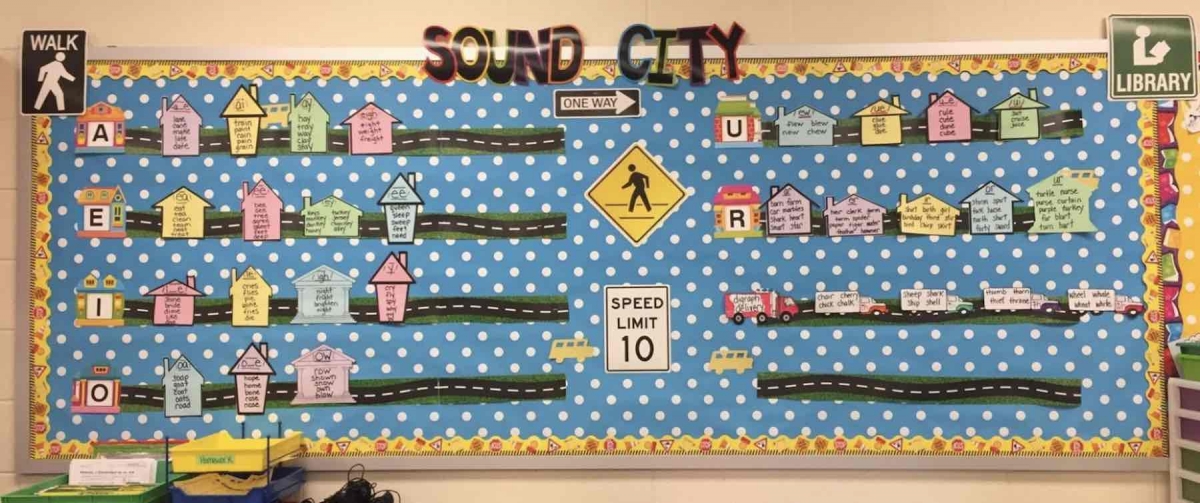
Second Grade Sound City
-
This city is designed with a grid system like city blocks.
-
The teacher chose to put Leftover Alley, Jingle Circle, and Barnyard Boulevard at the end of her horizontal streets.
-
The houses are constructed of simple rectangle and triangle shapes with a Post-it® note on each house. As it fills up, she places a new one on top.
-
The digraph delivery truck has only the digraphs written on it.
-
She also has a Senior Retreat, a babysitter club, and a jail. Some teachers prefer a timeout area.
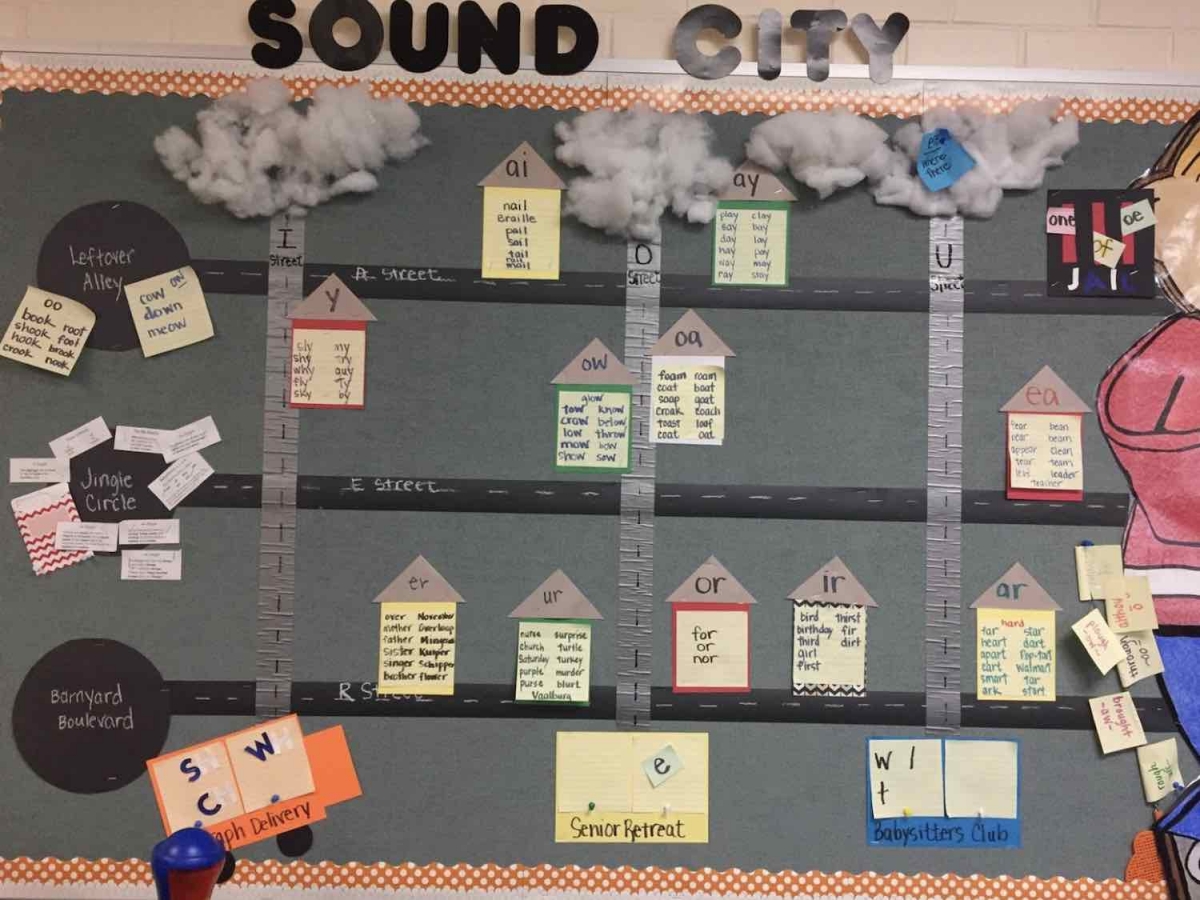
Monkey Tree
The Monkey Tree is not part of Sound City per se, but it takes the phonemes found on long “e” street and converts them into the Monkey Tree. It is so well thought out and cleverly teaches the many spellings of long “e” that it just had to be shared.
-
The tree trunk displays words spelled with “ee” as in tree.
-
Leaves are spelled with an “ea”, so they have words also spelled with “ea”.
-
Cherry is spelled with only a “y”, so all of the words written on the cherries also have only a “y”.
-
Monkey is spelled with an “ey”, so all of the words on the monkey’s sign are spelled with an “ey”. It appears there were quite a few children in the class whose names were spelled with “ey”!
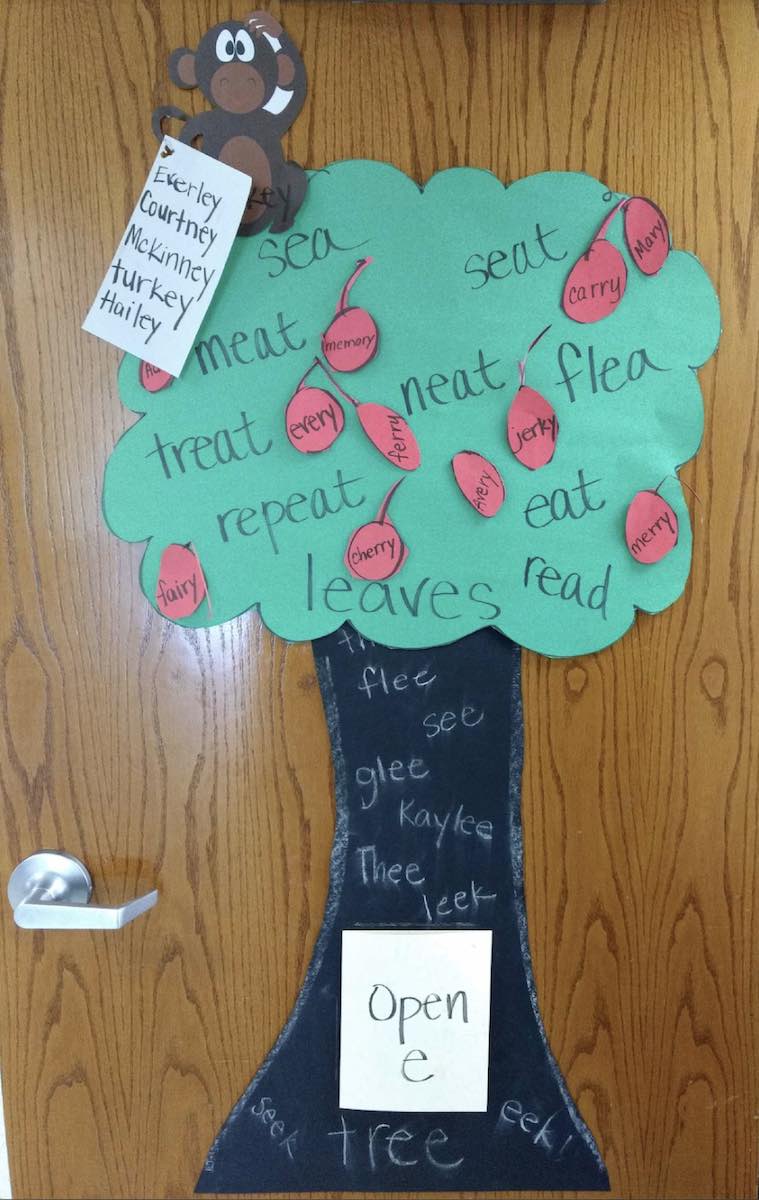
|
Linda Mikottis, BS SP ED, EL ED, and Accomplished IEW Instructor, is probably the least likely writing teacher you will ever meet. Never having learned to write well in school, she was convinced one was either born with the gift of writing or not. After discovering the Institute for Excellence in Writing methodology in 1996, Linda finally learned to write at the age of 34. No longer intimidated by writing, she was determined that others would not grow up as she did. Many of her successful students have been diagnosed with Asperger syndrome, learning disabilities, dyslexia, ADD, and ADHD. Linda now empowers children by empowering teachers through the hope IEW has to offer. |

